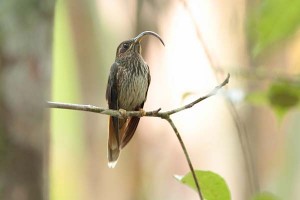Latest update April 21st, 2025 5:30 AM
Latest News
- Documents for Wales Gas-to-Energy project will be made public when entire scheme is completed- VP Jagdeo
- President Ali should determine whether Ramson should be sacked for non-performance – Jagdeo
- 31 Palestinians killed by bombs yesterday across Gaza
- Linden youths killed by police laid to rest
- Biker killed in Essequibo crash
The Buff-tailed sicklebill (Eutoxeres condamini)
Jun 14, 2015 Features / Columnists, Interesting Creatures in Guyana
The buff-tailed sicklebill (Eutoxeres condamini) is a species of hermit hummingbird from the lower Andes and adjacent west Amazonian lowlands from southern Colombia and northern Ecuador to
Peru and Bolivia.
With a total length of 5-6 inches (13–15 cm) and weighing 0.28-0.44 oz (8-12.5 g), it is a relatively large hummingbird. Males and females are virtually identical, differing only in size (especially wing measurements), with the females being some 20 per cent smaller.
Its upperparts are iridescent dull greenish, while the underparts are whitish, densely streaked with dusky. The neck-side has a relatively faint blue patch. The tips of the rectrices (tail feathers) are white, and there is a naked stripe on top of the head (but this is usually concealed).
The most conspicuous features, however, are those the common name refers to: the bill is strongly de-curved, and the outer three rectrices on each side are deep buff, best visible from below. Immature birds have light-tipped remiges (pinions), hardly any blue on the neck, and lack the naked crown stripe. Hatchlings have black skin and grey down.
There are two subspecies which are not very distinct and almost form a continuous cline, with an extensive inter-gradation zone in northern Peru: Eutoxeres condamini condamini (Bourcier, 1851) – northern buff-tailed sicklebill Colombia and Ecuador.
The buff outer remiges are the most reliable trait for separating the buff-tailed sicklebill from the only other member of the genus Eutoxeres, the white-tipped sicklebill (E. aquila), which has a more northerly distribution. The Eutoxeres species are somewhat sympatric however, for example in the foothills of Putumayo around Mocoa, Colombia.
It is restricted to the undergrowth of humid forested and wooded habitats, recorded from 590-10,800 ft (180-3,300 m) above sea level. It will tolerate more habitat disturbance than its congener, regularly occurring in plantations, bamboo stands and open habitat where populations are healthy, though it still prefers natural vegetation. Nothing precise is known about its movements, though it is presumed that the birds are non-migratory.
The peculiar bill is an adaption to the shape of certain flowers, namely of the genera Centropogon and Heliconia. It feeds mainly by trap-lining. In addition to nectar, it will also catch small arthropods.
The two white eggs are laid in a nest which is attached to the underside of a leaf, a few yards/metres above ground. In the southern Cordillera Oriental of Colombia, nest construction was observed in July or August, and in the lowlands of Ecuador’s Napo Province, in January. Birds with enlarged gonads were found in Peru from September to November. Only the female incubates; the incubation period is 16–18 days and the young fledge 22–24 days after hatching. They start to breed when they are 1–2 years old.
Generally fairly common though inconspicuous and easily overlooked, it is considered a species of Least Concern by the IUCN.
(Source: Wikipedia – The Free Online Encyclopedia)
Share this:
- Click to print (Opens in new window)
- Click to email a link to a friend (Opens in new window)
- Click to share on Facebook (Opens in new window)
- Click to share on WhatsApp (Opens in new window)
- Click to share on Twitter (Opens in new window)
- Click to share on Pinterest (Opens in new window)
- Click to share on Pocket (Opens in new window)
- Click to share on Tumblr (Opens in new window)
- Click to share on Reddit (Opens in new window)
- Click to share on LinkedIn (Opens in new window)
Related
Similar Articles

The Glenn Lall Show|| April, 14th, 2025
Follow on Tik Tok @Glennlall
THE BLUNT OF THE DAY

Sports
Apr 21, 2025
– Roberts, Persaud and Anderson in 800m finals today Kaieteur Sports- Ebo McNeil’s bronze medal in the Boys’ 3000m was Guyana’s only podium finish on day two of this year’s CARIFTA...Features/Columnists
Greater Civilian Involvement in the Guyana Police Force
Peeping Tom… Kaieteur News- The Guyana Police Force (GPF) is in the throes of a chronic manpower crisis. It is no secret... more
A Chance to steer U.S.–Caribbean Relations through Trade Winds and other Passing Storms
By Sir Ronald Sanders Kaieteur News- U.S. Secretary of State Marco Rubio has signaled a genuine willingness to hear the Caribbean... more
Publisher’s Note
Freedom of speech is our core value at Kaieteur News. If the letter/e-mail you sent was not published, and you believe that its contents were not libellous, let us know, please contact us by phone or email.
Feel free to send us your comments and/or criticisms.
Contact: 624-6456; 225-8452; 225-8458; 225-8463; 225-8465; 225-8473 or 225-8491.
Or by Email: [email protected] / [email protected]
Weekend Cartoon
















